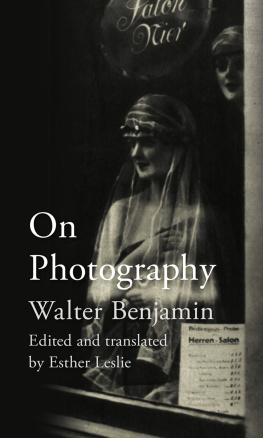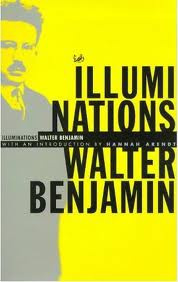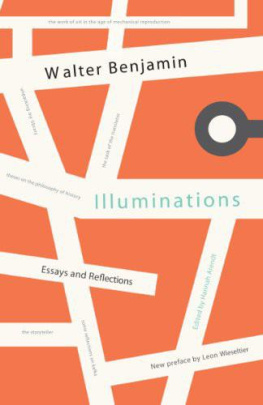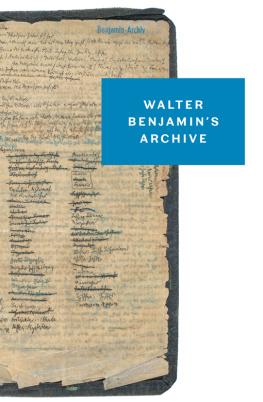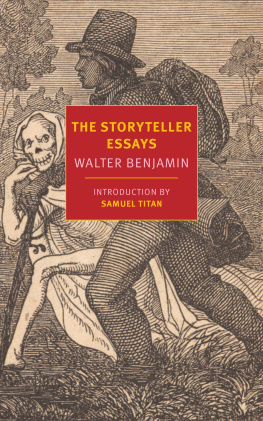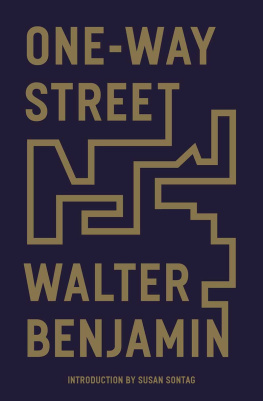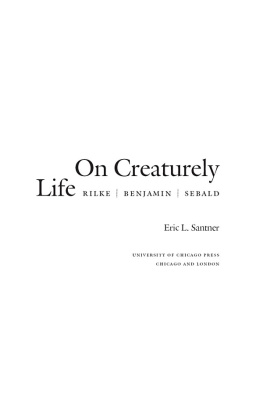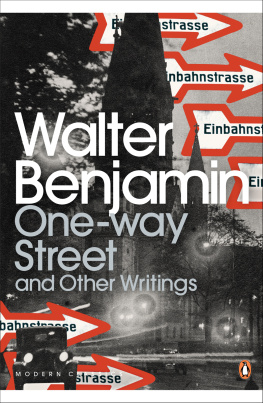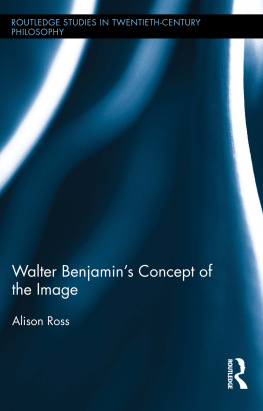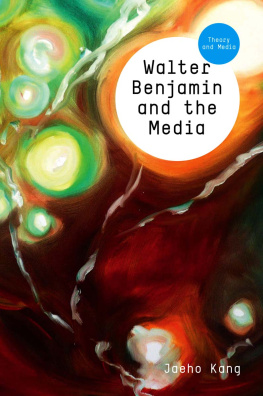Walter Benjamin - On Photography
Here you can read online Walter Benjamin - On Photography full text of the book (entire story) in english for free. Download pdf and epub, get meaning, cover and reviews about this ebook. year: 2015, publisher: Reaktion Books, genre: Religion. Description of the work, (preface) as well as reviews are available. Best literature library LitArk.com created for fans of good reading and offers a wide selection of genres:
Romance novel
Science fiction
Adventure
Detective
Science
History
Home and family
Prose
Art
Politics
Computer
Non-fiction
Religion
Business
Children
Humor
Choose a favorite category and find really read worthwhile books. Enjoy immersion in the world of imagination, feel the emotions of the characters or learn something new for yourself, make an fascinating discovery.
- Book:On Photography
- Author:
- Publisher:Reaktion Books
- Genre:
- Year:2015
- Rating:4 / 5
- Favourites:Add to favourites
- Your mark:
- 80
- 1
- 2
- 3
- 4
- 5
On Photography: summary, description and annotation
We offer to read an annotation, description, summary or preface (depends on what the author of the book "On Photography" wrote himself). If you haven't found the necessary information about the book — write in the comments, we will try to find it.
On Photography — read online for free the complete book (whole text) full work
Below is the text of the book, divided by pages. System saving the place of the last page read, allows you to conveniently read the book "On Photography" online for free, without having to search again every time where you left off. Put a bookmark, and you can go to the page where you finished reading at any time.
Font size:
Interval:
Bookmark:


Photography
by Esther Leslie
REAKTION BOOKS
Published by Reaktion Books Ltd
Unit 32, Waterside
4448 Wharf Road
London N1 7UX, UK
www.reaktionbooks.co.uk
First published 2015
Introduction, introductory texts and
glossaries copyright Esther Leslie 2015
Translations of texts by Walter Benjamin
copyright Esther Leslie 2015
All rights reserved No part of this publication may be reproduced, stored in a retrieval system, or transmitted, in any form or by any means, electronic, mechanical, photocopying, recording or otherwise, without the prior permission of the publishers
Page references in the Photo Acknowledgements
match the printed edition of this book.
Printed and bound in Great Britain
by Bell & Bain, Glasgow
A catalogue record for this book is available from the British Library
eISBN: 9781780235615
Introduction: Walter Benjamin and the Birth of Photography
ESTHER LESLIE

Benjamin as a child, c. 1897, photographed by the Selle & Kuntze studio.
Walter Benjamin was born into a world in which photography was becoming commonplace. In 1892, in Berlin, the year and place of his birth, photography wove its way into many peoples lives through the ritual visit of the bourgeois family to the studio to have portraits taken, an experience that Benjamin reflected on several times in his writings. In autobiographical reflections from the early 1930s, he relates how when as a child he was photographed in a studio with a crudely painted backdrop of the Alps, brandishing a kidskin hat, he felt that the screens and pedestals craved my image much as the shades of Hades craved the blood of the sacrificial animal. The photographic studio presented itself to him as a hybrid of boudoir and torture chamber. And there exists a photograph of him, at the age of five, standing alone, surrounded by a fuzzy oval, holding a sword and a flag and dressed up as a soldier. Studio photography compelled the subject, he noted, to adopt awkward poses, dress in clothes that are nothing but costumes, and gaze out from among a clutter of fake and random objects that engulf the fragile human body. Indeed, the imposturous and miserable but also simultaneously widespread nature of this experience is covertly publicized when Benjamin describes an image of Kafka that was in his possession. It is of Kafka as a boy, yet Benjamin describes it as if it were of himself:
In Benjamins interpretation, mechanical reproduction, or photography in this case and at this moment, assaults humanity and provides legible images of the dysfunctional relationship of technology, nature and social world by which humans increasingly become mere props an experience not reserved solely for the working-class appendage of the machine, as Karl Marx and Friedrich Engels described it in 1848 in The Communist Manifesto. This is how Benjamin saw a world of commercial photography designed to provide confidence-boosting photographs for well-heeled families to place inside heavy albums that rest as dust traps on dark sideboards in cluttered living rooms.
There were also more public encounters with photography in Benjamins childhood. The time of his growing up was the time of the emergence of the illustrated press, which was dependent on the rapid technical innovations in the field. In his year of birth, for example, the Berlin Illustrirte Zeitung (Berlin Illustrated Newspaper) first appeared, placing its speciality attention-grabbing pictures on its front cover. Engravings were soon replaced by photographs and, from 1901, photographs were printed inside the newspaper. Here was the start of photojournalism, and with it the professions of photojournalist and photo librarian were established.
As Benjamin grew, so too did access to making photographs. Processes simplified cheaper cameras were made and roll film was invented. In February 1900, Eastman Kodak Co. introduced to the U.S. market the Brownie camera, designed and manufactured for the company by Frank Brownell of Rochester, New York; the name Brownie was a reference to the pixie-like characters from Palmer Coxs popular childrens books, and illustrations of them appeared on the cameras early packaging. The young camera was, after all, designed for children. The new photography was to be a hobby for children, for the apparatus could be operated by any school boy or girl, as an advertisement from the Youths Companion put it in May 1900. In the event, much larger sections of the population adopted it. With the Brownie, the notion of the snapshot was inaugurated. Rapidly other companies started making similar cameras and they came into the hands of Europeans too. Moments of daily life, or at least its exhilarated moments at the beach, on the town, in the garden were recorded for posterity.
The invention in Germany of the Leica camera prototype, by a microscope designer on the eve of the First World War, contributed further to the pervasion of the world by photography. Once the war was over and the prototype improved, the Leica revealed itself to be a versatile, eye-level, daylight loadable compact camera that could snap precise shots in magnificent detail, using 35 mm motion picture film, which enabled it to shoot up to 36 rapid sequential exposures. Fast-paced modern life could be framed and captured by this device. During Benjamins passage from baby to adult, photography had developed: it had become faster, more capable and yet, in some regards, less demanding of skill on the part of the photographer.
Private and public, collective and individual, active and passive, productive and consumerist engagements with photography were all possible in the world in which Benjamin grew up. Photography had entwined itself in the mediation of the world. It had become not just a mediator of history but by the 1920s also had its own rich history and assured future. Benjamin reflected on all this in his scattered writings and jottings on photography. His thoughts encompass production, reproduction, sitter, viewer, temporality in the photograph, the economic situation of the photographer and this vis--vis the painter, the status of art and craft in relation to photography, the relationship of his curious category of aura to photography, the relation of photography and memory, and photographys potentials for knowledge and pedagogy.
Benjamin was aware of some of the debates around and practices of photography, not just as a bystander but as a discussant. In the course of his life, he came to know several professional photographers, including Sasha Stone, Gisle Freund and Germaine Krull, and he made the acquaintance of John Heartfield.
Walter Benjamin was not alone in turning to photography as a fount of interest. The Weimar Republic of Germany, in which he lived and studied until 1933 and where (having failed to secure an academic post) he became a reviewer and essay writer, housed a lively photographic culture. In 1929 the much-publicized Film und Foto exhibition opened in Stuttgart, organized for the Deutscher Werkbund by Gustav Stotz in order to bring together as comprehensively as possible works of all those who were the first to recognize that the camera is the most appropriate composition medium of our time and have worked with it. Around 1,200 works were on view, selected from across Europe and the United States, and the show, in reduced form, toured for two years through Zurich, Berlin, Vienna, Danzig, Zagreb and Munich, and also went to Japan. Film und Foto was a bold statement, phrased in Germany, about the importance of technological culture. The exhibition sampled some of the tendencies of photography in Europe of recent years. These tendencies, some of which were represented in the exhibition and all of which were practised in Germany, ranged from commercial photography to reportage photo-essays, art photography, avant-garde photobooks and political photomontage. Even within art photography, photographic trends ranged, within just a few years, from the quirky framings and high contrast of the Neues Sehen (New Vision), to the documentary precision and hyperrealism of Neue Sachlichkeit (New Objectivity, or Straight Photography as it was called in the U.S.), to Dada and Surrealist approaches to the image.
Font size:
Interval:
Bookmark:
Similar books «On Photography»
Look at similar books to On Photography. We have selected literature similar in name and meaning in the hope of providing readers with more options to find new, interesting, not yet read works.
Discussion, reviews of the book On Photography and just readers' own opinions. Leave your comments, write what you think about the work, its meaning or the main characters. Specify what exactly you liked and what you didn't like, and why you think so.

